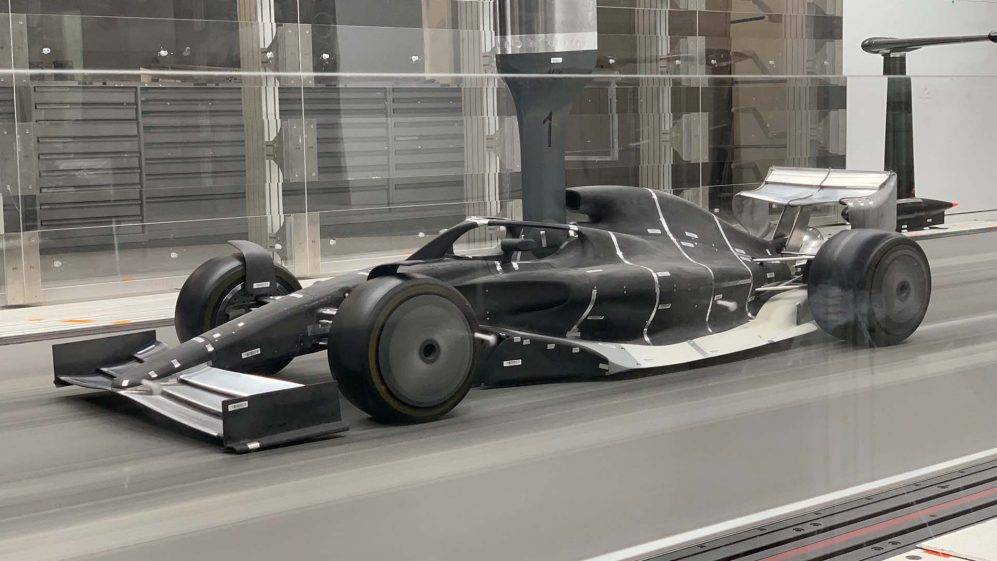Formula One (F1), the premier world championship for motor racing and its governing body the Fédération Internationale de l’Automobile (FIA), have used additive manufacturing to help determine the design, rules and regulations of its 2021 cars.
Each F1 season, the FIA issues new regulations for vehicles participating in the championship. The new rules are tested using prototype car models implemented. Last month, the 2021 vehicle underwent extensive wind tunnel testing using an accurate, 50 percent scale model produced with the help of additive manufacturing.
The wind tunnel tests were performed by an independent consultancy group from Sauber, a Swiss motorsport engineering company, using its own wind tunnel facility. The use of additive manufacturing to create the scale models delivered a number of benefits to the development team. Pat Symonds, F1’s Chief Technical Officer, stated “50% is a good compromise in that we can still get a good level of detail on the model but we still have distance behind. It’s true teams have tended to go more to 60% these days.”
“THERE ARE ADVANTAGES TO THAT, IN MODELLING, BUT MODERN MANUFACTURING TECHNIQUES, PARTICULARLY ADDITIVE MANUFACTURING AND STUFF LIKE THAT ALLOWS YOU TO MAKE VERY ACCURATE 50% MODELS THESE DAYS.”

Additive manufacturing proves valuable in the wake of F1 testing
For the 2021 season Nikolas Tombazis, FIA’s Head of Single Seater Technical Matters, has said that the federation has expressed a desire to “break the rules.” This is in order to push the current regulations to the extreme, identifying loopholes and unintended consequences. A significant target for the 2021 rules revolves around encouraging racers to overtake each other. As a result, the FIA has been reported to have completed an unprecedented amount of Computational Fluid Dynamics (CFD) R&D to help realize its 2021 vehicles. Wind tunnel testing was performed to help confirm the data produced by the CFD research.
The initial test was completed in January 2019, where a 2018 60 percent scale model was wind tunnel tested. In the following March, another test was taken using a 2021 model using 13 inch wheels, however 2021 regulations will soon demand that all F1 cars must use 18 inch wheels on the track. A 50 percent model of the 2021 car with the correctly fitted 18 inch wheels was then tested at the Sauber wind tunnel in July.
F1 has provided a video depicting the wind tunnel testing of the 2021 50 percent scale model running for the first time with 18 inch tyres, a process often kept confidential by the organization. The Sauber wind tunnel’s automatic rake system can be seen moving behind the car in order to measure it’s airflow, or “wake.” The wake is being monitored so the F1 and FIA can attempt to improve the ability for cars to follow behind each other, and subsequently overtake the other vehicle. A significant element of measuring the wake of the 2021 vehicle lies in the production of a detailed 50 percent scale sized model enabled by 3D printing.
100 percent scale cars have been banned for use in wind tunnel testing in F1 due to the huge cost of manufacturing the model. F1 teams have instead mostly adopted 60 percent models for wind tunnel testing, however F1 and the FIA have leveraged the benefits of additive manufacturing to produce a detailed model at 50 percent scale, without sacrificing accuracy. A smaller size means more room in the wind tunnel behind the car, allowing for a detailed inspection of the car’s wake.
3D printing in F1
Many F1 racing teams now integrate additive manufacturing for prototyping and producing parts that improve car performance. Most recently Jabil, an American worldwide manufacturing services company, announced a partnership with the Renault F1 Team to produce 3D printed car parts for its F1 car competing in the 2019 Formula One World Championship.
Longstanding 3D printing partnerships also exist between Stratasys and McLaren, Willians and EOS, Sauber and Additive Industries, and Ferrari and Magneti Marelli.
Source: 3dprintingindustry


